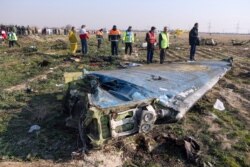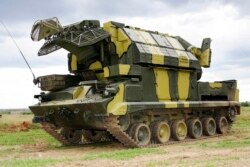Update: On Jan. 11 after days of denials, Iran confirmed that the country's forces mistakenly shot down Ukraine International Airlines Flight PS752. In a statement on Twitter, Iranian President Hassan Rouhani said Iran "deeply regrets this disastrous mistake."
The crash of Ukrainian International Airlines flight PS752 killed 176 passengers and crew on Jan. 8, shortly after Iran launched a ballistic missile attack against U.S. bases in Iraq. The head of Iran’s Civil Aviation Organization (CAO.IRI), Ali Abedzadeh, said it was “scientifically impossible” that the plane had been taken down by Iranian air defense systems deployed after the missile attack.
The crash occurred minutes after takeoff at the Tehran Imam Khomeini International Airport. On Jan. 9, the Russian state-owned news agency RIA Novosti quoted Abedzadeh as saying: “The version that the plane was shot down by a rocket cannot be true under any circumstances … it is impossible from the scientific point of view.”
The rationale behind the Iranian official’s claim is unclear from the RIA Novosti article. However, variations of Abedzadeh’s statement were reported by Iranian news agencies and provide more insight.
The Tehran Times has the fullest version of the statement: “From a scientific viewpoint, it is impossible that a missile hit the Ukrainian plane.”
“We can say that the airplane, considering the kind of the crash and the pilot’s efforts to return it to Imam Khomeini airport, didn’t explode in the air. So, the allegation that it was hit by missiles is totally ruled out.”
So, Iran’s explanation relies on the fact that the plane did not blow up and that the pilot retained enough control to turn back toward the airport.
“The Iranian claim is nonsense,” Riki Ellison, a defense expert and founder of the Missile Defense Advocacy Alliance, told Polygraph.info. Ellison is among multiple officials or experts who have flagged Iran air defenses as the likely cause.
In this case, the alleged surface-to-air rocket launcher was quickly identified as the Russian-made Tor-M1, a mobile unit Iran has purchased from Russia.
The Tor-M1, which NATO calls the SA-15 Gauntlet, is a short-range “point defense” system that integrates the missile launcher and radar in a single tracked vehicle, according to Reuters. The Tor is designed to be lethal against targets at altitudes up to 6,000 meters (20,000 feet) and at ranges of 12 kilometers (7.5 miles). The Ukrainian airliner had ascended to 2,416 meters (7,925 feet) before it went down.
Ellison said the argument that the pilot was able to turn the plane around was deceptive. “What does that have to do with being hit by a missile?” He said there is “evidence that the plane was hit by two rockets, and the pilot must have seen what was coming onto him. And so, he may have tried to turn away from the missiles.”
An extensive analysis of cellphone video by the investigative website bellingcat shows what appears to be a rocket arcing through the night sky and exploding near the airliner as it climbs.
U.S. Secretary of State Mike Pompeo and other officials have said intelligence reports strongly suggest Iran’s air defense system mistakenly shot down the plane. Canadian Prime Minister Justin Trudeau made the same assertion, citing intelligence from the U.S., Canada and other sources, as did British Prime Minister Boris Johnson and Oleksiy Danilov, secretary of Ukraine's National Security and Defense Council.
As reported by Al Jazeera, Danilov said Ukrainian investigators intend “to look for the debris of a Russian Tor air defense missile."
Abedzadeh’s argument that the plane did not explode and, therefore, could not have been struck by a missile doesn’t apply because of how the Tor missile works, Ellison said.
“The SA-15 air defense weapon that has been used has fragmentation devices, so it gets close to the target, then releases small objects, like shrapnel. That doesn’t destroy the whole plane, but takes part of the plane out. So, the second claim is not true, the plane does not explode in the air,” Ellison explained.
The Iranian claims also clash with past incidents in which pilots whose aircraft were attacked by rockets have been able to safely land or bail out.
In 2003, pilots were able to land an Airbus owned by the courier DHL after it was hit by a Russian-made SAM-7 surface-to-air missile at Baghdad airport. The rocket set fire to the plane’s left wing. No one was injured.
In August 2010, an Iranian Air Force F-4 Phantom fighter mistakenly entered a 20-kilometer no-fly zone around the Bushehr Nuclear Power Plant, which was being guarded by the Iranian armed forces on high alert.
Reportedly due to miscommunication, the Islamic Revolutionary Guard Corps’ Tor-M1 units misinterpreted the friendly jet as hostile. The Iranian pilots managed to eject and survive.








